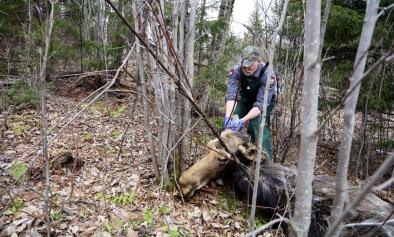Science Source
Climate change affects bird nesting phenology: Comparing contemporary field and historical museum nesting records
Study key findings & significance
- Many species of birds in the Chicago area are nesting and laying eggs nearly a month earlier than they did a century ago.
- These species, including bluejays, yellow warblers and field sparrows, are now laying their first eggs 25 days earlier, on average, than they were 100 years ago.
Author quotes
“It was shocking to find this. What we can see is clearly pointing in the direction that climate change is having a significant effect on the behavior of birds. It’s another piece of the puzzle we are trying to figure out in terms of impacts.”
“If you’re a bird and you nest earlier, you put yourself at risk of these cold snaps that can still arrive in spring, which then affects the plants and insects. That then impacts the reproductive success of the birds. Springs are becoming more volatile and that is taking its toll.”
John Bates, curator of birds at the Field Museum and the study’s lead author
Abstract
- Global climate change impacts species and ecosystems in potentially harmful ways. For migratory bird species, earlier spring warm-up could lead to a mismatch between nesting activities and food availability. CO2 provides a useful proxy for temperature and an environmental indicator of climate change when temperature data are not available for an entire time series.
- Our objectives were to (a) examine nesting phenology over time; (b) determine how nesting phenology relates to changes in atmospheric CO2 concentration; and (c) demonstrate the usefulness of historical museum collections combined with modern observations for trend analyses.
- We assessed changes in nesting dates of 72 bird species in the Upper Midwest of the United States by comparing contemporary lay dates with those obtained from archived, historical museum nest records over a 143-year period (1872–2015).
- Species-specific changes in lay date per one unit change in the CO2 residual ranged from −0.75 (95% CI: −1.57 to −0.10) to 0.45 (95% CI: −0.29 to 1.43). Overall, lay dates advanced ~10 days over the 143-year period. Resident, short-distance migrants and long-distance migrants lay dates advanced by ~15, 18 and 16 days on average respectively. Twenty-four species (33.3%) significantly advanced, one (1.4%) significantly delayed and we failed to detect an advance or delay in lay date for 47 species (65.3%). Overall mean advance in first lay date (for the species that have significantly advanced laying date) was 25.1 days (min: 10.7, max: 49.9).
- Our study highlights the scientific importance of both data gathering and archiving through time to understand phenological change. The detailed archived information reported by egg collectors provide the early data of our study. As with studies of egg-shell thinning and pesticide exposure, our use of these data illustrates another scientific utility of egg collections that these pioneer naturalists never imagined. As museums archive historical data, these locations are also ideal candidates to store contemporary field data as it is collected. Together, such information will provide the ability to track, understand and perhaps predict responses to human-driven environmental change.
Related Content
Science Source
| Global Change Biology
Decadal-scale phenology and seasonal climate drivers of migratory baleen whales in a rapidly warming marine ecosystem
Daniel E. Pendleton, Morgan W. Tingley, Laura C. Ganley et al
Headline

May 19, 2022 | Climate Nexus Hot News
Climate Change Great For Winter Ticks, Very Bad For Moose Calves
Science Source
Climate change increases cross-species viral transmission risk
Colin J. Carlson, Gregory F. Albery, Cory Merow et al
Science Source
| Global Change Biology
Timing and magnitude of climate-driven range shifts in transboundary fish stocks challenge their management
Juliano Palacios-Abrantes, Thomas L. Frölicher, Gabriel Reygondeau et al


